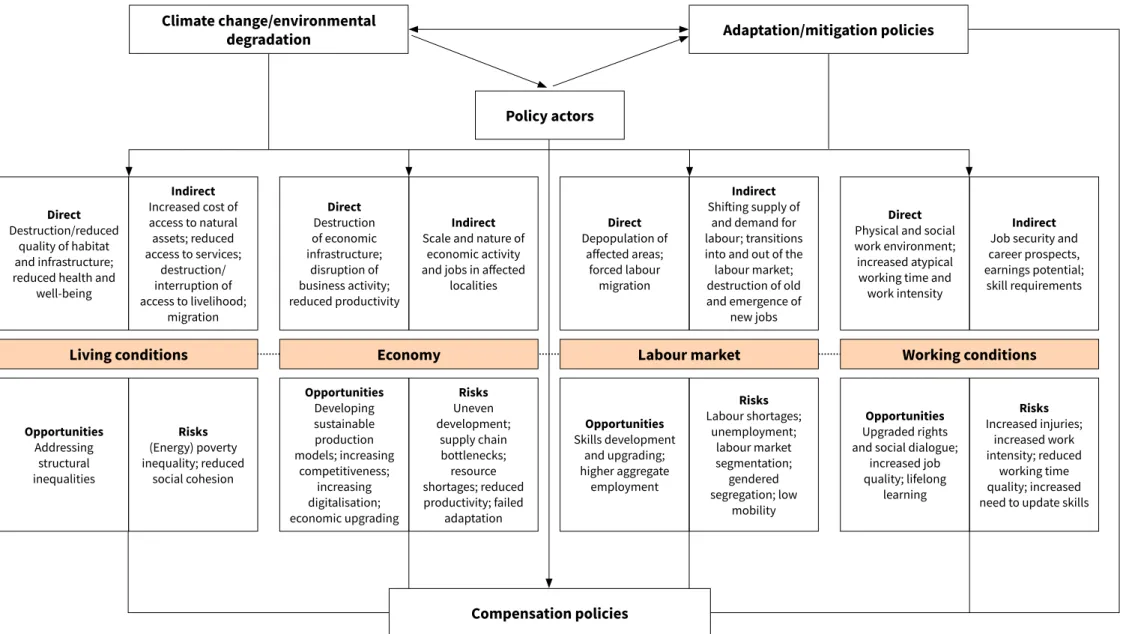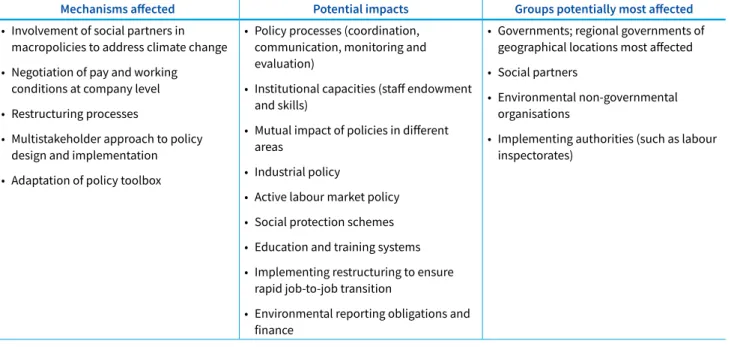For example, the economic effects of climate change and climate change policies have consequences for both labor markets and social conditions. The following sections discuss in turn the impacts of climate change and climate change policies on each of the areas outlined in the current theoretical framework.

1 Socioeconomic effects of climate change and environmental
This again indicates that the most vulnerable groups are likely to remain trapped in the regions most affected by climate change. Moreover, given the existing inequalities in the labor market, climate change is also likely to lead to more polarization and inequalities in the labor market.
Physical and social environment
Vulnerable groups in the labor market, such as low-skilled workers and workers on irregular contracts. In addition to being professional/occupational and sectoral, these impacts of climate change are expected to be highly regionalized and have different consequences for different groups in the labor market. In the worst cases, this can lead to temporary or chronic ill health or death, with negative consequences for not only the individual, but the health of the population and the wider economy (Lucas et al, 2014; Narocki, 2021).
Heat stress can lead to harmful physiological changes in the body and psychological consequences that can also affect the social work environment and contribute to unfavorable social behaviour. It has also been shown that high temperatures increase the risk of certain chemical substances/pollutants that may be present in the workplace. This stems from a resolution passed by the ETUC in 2018 calling for workers to be protected from high temperatures in the workplace (ETUC, 2019).
Work intensity and working time quality
This, in turn, can lead to physical and physiological changes that affect performance and contribute to adverse health outcomes, accidents and occupational injuries. This is particularly the case in outdoor environments (e.g. in agriculture and construction; Levy and Roelofs, 2019) and in poorly ventilated or poorly controlled indoor environments, especially where machinery can contribute to temperature rises. Health effects may be short-lived or contribute to the onset or precipitation of chronic disease.
High temperatures have been shown to have a particularly negative impact on pregnant women and can cause birth defects and contribute to the risk of miscarriage, low birth weight and other malformations (Zhang et al, 2019). In addition to affecting productivity (see 'Consequences for the economy and the labor market' above), this combination of harmful factors can affect cognitive performance, which can contribute to occupational accidents (Schulte and Chun, 2009; . Schulte et al, 2016; Andrews et al. , 2018). Heat stress is a social hazard that affects not only individuals but also communities and, through its impact on productivity, the economy (Kjellstrom et al, 2016).
Skills and discretion, prospects and earnings
According to the IPCC (2014b, p. 4), the goal of mitigation is to “stabilize greenhouse gas levels within a time frame sufficient to allow ecosystems to adapt naturally to climate change, ensure that food production is not threatened and enable economic development to continue in a sustainable way'. Further research into the effects of the EU Emissions Trading System (ETS) on business location decisions shows that the policy did not result in significant additional costs, nor did it induce a fundamental shift in strategy (Martin et al, 2016). .A significant part of the Recovery and Resilience Facility is also dedicated to measures to address the unequal social and labor market consequences of the twin transition.
Furthermore, the implications of this impact on (perceived) fairness and social cohesion must also be considered, as clearly demonstrated by the rise of the. Several of the IGO policy instruments have clear links to improving living conditions. Finally, the Regulation on the Governance of the Energy Union and Climate Action defines a governance process to monitor and report on energy poverty, and to set quantifiable national targets for its alleviation.

Most of the existing evidence from the EU agrees that the impact of low-emission transition mechanisms and decarbonisation policies on employment will be around -2.4% in the period to 2050 (ESDE, 2019). In summary, the transition to a robust and low-carbon EU economy will have significant labor market impacts in sectors that are more likely to be affected by green policies due to the intensity of resource consumption. Second, and partly as a result of the earlier, uncoordinated data collection by national statistical offices has given rise to inconsistent empirical accounts.
Enhanced skills Existing occupations that may require changes in tasks, skills and knowledge as a result of the transition to a carbon neutral economy, although the essential purpose of the occupation remains unchanged. As indicated above, the workforce affected is predominantly male, given the nature of the sectors, occupations and tasks affected (agriculture, mining and quarrying, construction, transportation and storage). In addition, the emergence of green entrepreneurship is an example of the impact of climate change on the economy.

4 Impacts on working conditions and job quality
It is worth noting that changes in physical hazards tend to be concentrated in sectors and occupations dominated by predominantly male workforces. This aspect of job quality, which includes decision-making space, organizational participation and training, among others, tends to be lowest among workers in the agriculture and transport sectors, followed by trade, hospitality and industry. Therefore, any quantitative employment shift away from these sectors is likely to have a positive effect on job quality, especially if newly created jobs are more likely to be found in the service sector and higher skilled occupations.
Training and task autonomy are also rated as greater among new and emerging jobs (Eurofound, 2022c). An example of this is labor inspectorates; they need to be equipped for the changes in the labor market driven by climate change, such as health and safety issues related to 'green jobs', first responders to natural disasters or the aforementioned workplace aspects such as rising temperatures or biohazards, which are likely to have the greatest impact have on vulnerable groups such as migrants (Nordic Future of Work Group, 2020). This is considered an important condition for effective sustainability policies (Markantonia et al, 2018).
Industrial policy and regional planning
Labour market policy
Education and training policy
Social protection
Health and emergency services
National
Regional
Sectoral and company
In the medium term, the services provided and delivery mechanisms will need to adapt to the impact of climate change and climate change policies. The social partners have a crucial role to play in the development and implementation of responses to the consequences of climate change and climate change policies, including in relation to the other megatrends outlined in the introduction. Both have an impact on the potential influence of social partner organisations, including their involvement in climate change policies and collective bargaining to address such issues and the impact of climate change policies at different levels.
As already mentioned, in the context of the impact of climate change and climate change policy, the role of social partners in the design and implementation of content and the implementation of active labor market and training policy and social policies is particularly important. In relation to all of the above, the role of social partners is clearly not limited to the impact of climate change and climate change policy, but their involvement and experience in dealing with other change processes is crucial in shaping their increasing involvement in climate change. related challenges. Not surprisingly, many of these texts originate from the energy and extractive industries and address the impact of climate change policy objectives on business and employment.

6 Future perspectives for research and analysis
To better understand what works and what doesn't, where and why, more first-hand evidence of (un)successful policy implementation is needed. The distributional effects of climate change and climate policies at the societal level also require further investigation. In particular, there is little research on the extent to which (i) low-carbon fiscal policies are regressive or not, and (ii) the monetary and environmental benefits of these policies improve the living conditions of vulnerable communities and individuals.
There is little research on the extent to which coordination in the implementation of policy instruments across countries can generate inefficiencies or accumulate positive environmental and social impacts, which is an important and unavoidable challenge for European society. An appropriate monitoring framework should be established to assess the socio-economic impacts of climate change and climate change policies. Recently, there is a growing interest in the opportunities and risks of cross-fertilization in megatrends, but limited information about them.
Research Policy, Vol. 2008), Adaptation to climate change, disaster risk reduction and social protection, briefing note, Center for Social Protection, Center for Climate Change and Development, Brighton. A Guide for Existing Firms, California Management Review, Vol. 2019), 'Linking climate change, land use and conflict', Climate Change Current Reports, Vol. eds.), The Palgrave manual of environmental labor studies, Palgrave Macmillan, Cham, Switzerland, pp. 2007), 'A meta-analysis of performance response under thermal stressors', Human Factors, Vol. 2011), Towards an ILO approach to climate change adaptation, International Labor Organization.
Journal of Development Economics, Vol. 2020), Just transition in connection with EU environmental policy and the European Green Deal, issue paper under task 3 of the service contract on future EU environmental policy, Öko-institut e.V., Freiburg. A few points of clarification', Globalizations, Vol. 2017), 'Influence of climate change on summer cooling costs and heat stress in urban office buildings', Climatic Change, Vol. 2012), 'The lasting impact of the American Dust Bowl: Short- and long-run adjustments to environmental catastrophe', American Economic Review, Vol. A significant ergonomic challenge and health risk for current and future workers, Extreme Physiology & Medicine, Vol. 2021), “The Impact of Energy Prices on Socio-Economic and Environmental Performance:.
Review of Environmental Economics and Policy, vol. 2007), 'Network effects and the dynamics of migration and inequality: Theory and evidence from Mexico', Journal of Development Economics, Vol. Building capacity to deal with climate challenges today and in the future', Journal of Environment and Development, Vol. 2019), 'Social protection integration and climate change adaptation: An overview', WIREs Climate Change, vol.



